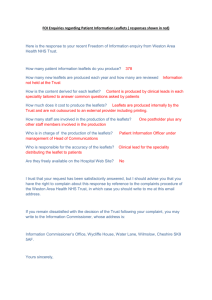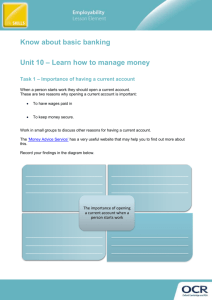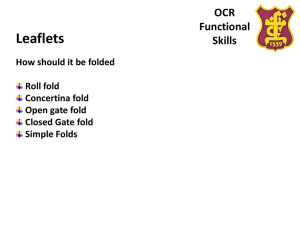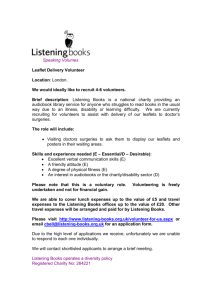Down syndrome screening leaflets
advertisement
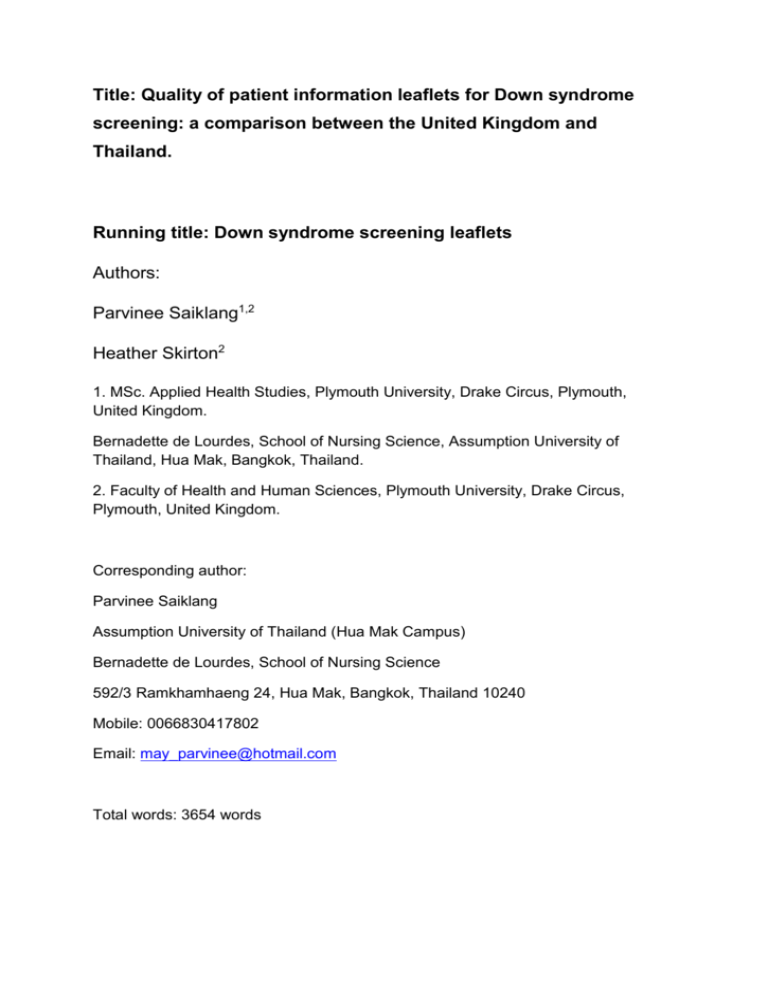
Title: Quality of patient information leaflets for Down syndrome screening: a comparison between the United Kingdom and Thailand. Running title: Down syndrome screening leaflets Authors: Parvinee Saiklang1,2 Heather Skirton2 1. MSc. Applied Health Studies, Plymouth University, Drake Circus, Plymouth, United Kingdom. Bernadette de Lourdes, School of Nursing Science, Assumption University of Thailand, Hua Mak, Bangkok, Thailand. 2. Faculty of Health and Human Sciences, Plymouth University, Drake Circus, Plymouth, United Kingdom. Corresponding author: Parvinee Saiklang Assumption University of Thailand (Hua Mak Campus) Bernadette de Lourdes, School of Nursing Science 592/3 Ramkhamhaeng 24, Hua Mak, Bangkok, Thailand 10240 Mobile: 0066830417802 Email: may_parvinee@hotmail.com Total words: 3654 words Abstract Prenatal screening tests can help to estimate the possibility of a pregnant woman having a baby with trisomy 21 (Down syndrome). As these tests are optional, it is essential that women are provided with appropriate verbal and written information to enable them to make an informed choice. The aim of this study was to assess the content and quality of Down syndrome screening information leaflets used by health professionals to provide information to pregnant women in the UK (26 leaflets) and Thailand (11 leaflets). We collected leaflets from health institutions and the Internet and compared the topics covered in each one against recommendations for patient information on this topic. We also assessed the quality of each leaflet using the DISCERN-genetics tool. While the quality rating score of UK leaflets was significantly higher than Thai leaflets, none of the leaflets included all the recommended topics: some contained erroneous material. In both countries the quality of information can be improved to provide accurate information to women and their partners, which is essential to ensure prospective parents can make informed choices during pregnancy. Key words Antenatal screening; prenatal screening; Down syndrome; trisomy; patient information; informed consent; fetal; genetic testing, aneuploidy. Introduction Prenatal screening tests can help clinicians to estimate the possibility of a pregnant woman having a baby with a chromosomal abnormality: the main focus of such screening is the detection of aneuploidy, principally trisomy 21, known as Down syndrome (DS) (Alfirevic et al, 2003). Down syndrome screening (DSS) is performed via biochemical tests on maternal serum and/or ultrasound scanning but in order to obtain a firm diagnosis women may be offered invasive tests, which carry a small chance of miscarriage (Alfirevic et al, 2003). Following screening, parents may ultimately be faced with making a decision about whether to terminate the pregnancy if the result of the diagnostic test is positive (Royal College of Obstetricians and Gynaecologists, 2010). While prenatal screening for fetal abnormality is offered to pregnant women in many countries (Skirton et al., 2008), in this study we focussed on screening offered in the United Kingdom and Thailand. In the United Kingdom (UK) health care is provided free of charge (at the point of service) by the National Health Service (NHS), this includes midwifery care for every woman throughout her pregnancy (Skirton et al., 2008). Prenatal screening for DS is routinely offered to pregnant women as part of NHS care (Hall et al., 2007) but is also available via private healthcare services. Thailand has a developing health service and funding for healthcare varies according to the individual’s economic situation. Payment for services may be covered by private health insurance, selfpayment or social security schemes (Pruksanusak et al., 2009). Titapant (2012) noted that around 1,000 babies are born with DS per year in Thailand. However, DS screening is not offered routinely as a part of prenatal care in Thailand and most maternal serum screening services are available via private health care services (Pruksanusak et al., 2009). The UK and Thailand have different cultures, religion, health care systems and economic situations. However, all women who are offered prenatal screening for fetal abnormality should be provided with sufficient and appropriate information about the test and its possible consequences (Murray et al., 2001). Literature review Parents may find it difficult to make informed choices if they have not received information and support from health professionals (Gammons et al., 2010) and according to Arnold (2007), patients will be more inclined to make their own treatment choices and actively participate in their health care if they receive the appropriate information. However other authors claim that parents do not always received helpful information in order to make informed choices (Gammons et al., 2010; Stapleton et al., 2002). Furthermore, verbal explanations about DS screening tests are not sufficient and women should also be provided with written material in the form of a national or local leaflet to accompany the verbal information (UK National Screening Committee, 2007; Bryant et al., 2001). Leaflets used to support decision making need to include sufficient information about forms of screening, possible adverse effects and autonomy to decline tests (Moore, 1999). The information should also include false positive and false negative rates, the type of screening offered, the limitation of the screening tests, information about DS, possible results and an explanation that the screening tests are optional (UK National Screening Committee, 2007). However, the literature on this topic indicates this is not always the case, especially in respect of presenting an unbiased view and emphasis on choice for parents, leading Hall et al., (2007) to suggest that leaflets from different countries reflected the variation in attitudes of different cultures toward informed choice. .A good balance between negative, positive and neutral information should be included in screening leaflets to promote informed choice (Hall et al., 2007; Bryant et al., 2001; Loeben et al, 1998), but previous studies show that negative descriptions of DS are more common, without a balance of positive and neutral content (Hall et al, 2007;). Bryant et al., (2001) found the majority of descriptions of DS were rated negatively in content and tone, while in another study more than half of all extracted statements about DS in leaflets from seven countries were negative (Hall et al, 2007). When compared to leaflets from another six countries, a leaflet used in the UK was found to contain the lowest number of negative descriptions of DS, (Hall et al, 2007), while the Chinese leaflet contained the most negative descriptions of DS and did not include any mention of informed choice regarding the screening test (Hall et al, 2007). These findings are important because Figueiras et al, (1999) reported that negative textual description of DS increased the expectation to terminate an affected pregnancy, when compared with neutral or positive text. Moreover, expectation of undergoing prenatal testing is increased by receiving both positive and negative pictorial information on DS (Figueiras et al, 1999). Murray et al, (2001) found that a small number of leaflets included almost all the basic topics recommended for inclusion by the Royal College of Obstetricians and Gynaecologists (1993), however incorrect terminology was often used to describe the screening results (Murray et al, 2001). For example, in many leaflets the term ‘at risk’ was used to describe women with high risk results, while in some leaflets the term ‘ normal’ was used in relation to a low risk result (Murray et al, 2001). This misuse of terminology may lead women with low risk results to assume there is no residual risk. Moreover, using term ‘positive or negative’ may mislead women regarding the meaning of the screening result (Carroll et al, 2000). Given the potential concern over quality of information leaflets for women considering screening for fetal abnormalities, we decided to conduct an empirical study to evaluate and compare the quality of leaflets used in two countries, one where screening is offered routinely to all pregnant women (UK), the other where screening is available but offered on a less routine basis (Thailand). Study aim The aim of this study was to assess the content and quality of DSS information leaflets used by health professionals to provide information to pregnant women in the UK and Thailand. Methods We conducted a cross-sectional survey of information leaflets. There were three phases to the study: quantitative content analysis, quality assessment using the DISCERN-genetics rating scale (Shepperd et al., 2006) and comparison of the attributes of leaflets from the UK and Thailand. Sample We aimed to collect a range of 10- 20 leaflets from each country, with examples used in both public and private healthcare institutions. United Kingdom A search for DSS information leaflets was conducted online using the Google search engine, the key words were “Down syndrome screening information leaflets” or “Down syndrome screening leaflets”. Thirty-four leaflets in either PDF or Word Document format were obtained from the web pages of both public and private healthcare services in England. Eight leaflets were excluded from the study because they were not focussed on DS screening in normal pregnancy, and the another leaflet related to a test that is not yet routinely offered in the healthcare service, resulting in a total of 26 screening information leaflets to be evaluated (Figure 1). Thailand There were 25 hospitals in Bangkok with available website and email addresses. Emails were sent to those hospitals requesting copies of their DSS information leaflets. Ten private hospitals responded to the emails but only three of these sent leaflets fitting the inclusion criteria. The remainder had no written information for patients (even though DSS was available there) or sent leaflets related to diagnostic tests. Therefore, only three leaflets were collected by making email contact with organisations (see figure 2). We therefore took another approach and visited fortyfour Bangkok hospitals in person. One of these did not provide a DSS service; seven provided a total of eight information leaflets. There was therefore a total of 11 of Thai leaflets used in the study (see figure 2), all of which were translated into English and checked by two fluent bilingual Thai and English speakers. Place Figure 1 here. Place Figure 2 here. Ethical considerations The research study protocol was reviewed by the Student Ethics Committee of the Faculty of Health, Education and Society at Plymouth University. As primary empirical data were not collected, ethical approval was not required. Each leaflet was assigned a letter and number for the purpose of the study (for example, English leaflets were labelled EGn or EPn and Thai leaflets TGn or EPn) analysis, so leaflets from any individual organisation were not identifiable in the report. Data analysis Phase 1: analysis of content A list of topics (included in Table 2) to be included in antenatal screening information provided to women was developed using the UK National Screening Committee (NSC) recommendations (cited in Skirton and Barr, 2007) and the antenatal screening working standards for DSS that were produced later by the NSC (National Screening Committee, 2007). Two studies related to DSS information were used as additional sources of topics (Bryant et al, 2001; Murray et al, 2001). The QSR International’s NVivo9 qualitative data analysis software was used for coding. The content of each leaflet was coded according to topics covered and the data were entered into a spreadsheet, a form of deductive thematic analysis described by Braun and Clarke (2006). Additional topics were created using codes that did not fit the recommended topics (Elo and Kyngas, 2007). An example of the coding frame is given in Table 1. The coding was undertaken independently by two researchers and results compared. Where there were discrepancies in coding these were discussed until consensus was reached. Place Table 1 here Phase 2: quality assessment The quality of leaflets in this study was assessed independently by both authors by using DISCERN-genetics tool (Discern Genetics, 2005), which comprises twenty questions (see Figure 3). According to the coding instructions, a score ranging from 1 (No) to 5 (Yes) is used to rate each question. A score of 5 indicates the quality criteria have been completely achieved, scores of 2, 3 or 4 (partially) indicate a moderate rating, i.e. the publication has met some criteria and a score of 1 indicates the publication has not met the criteria at all (Discern Genetics, 2005). Place figure 3 about here Phase 3: comparison Descriptive statistics were used to present the mean, minimum and maximum quality score of UK and Thai leaflets. The content and quality of leaflets from the two countries were compared using the Mann-Whitney U test (Cohen and Lea, 2004). Results General description of the leaflets The number of A4 size pages included in UK leaflets was 2 – 60 pages. Of 11 leaflets from Thailand, most were presented as a page of A4 folded into three columns. Every leaflet from UK and Thailand included DS as the main condition discussed. Information on open neural tube defect (NTD), Edwards syndrome (trisomy 18), and Patau syndrome (trisomy 13) was included in many leaflets from the UK, as well as other conditions such as heart problems, inherited blood disorders and unspecified disorders. There were four other main conditions covered in half of Thai leaflets: NTD, Edwards syndrome, Patau syndrome and triploidy. The DSS information from both countries included one or more types of screening test, as well as diagnostic tests. The combined test was the most common screening test described in leaflets from both countries. Place Table 2 about here. Content analysis Table 2. provides the results of the content analysis for leaflets from both countries. UK leaflets Every leaflet included a minimum of nine of the 37 recommended themes. The highest number of recommended themes was 23. The type of test offered was included in 100% (n=26) leaflets. There were 19 recommended themes that were found in less than 50% of total leaflets and none of the leaflets included material related to ‘Psychosocial/emotional aspects of parenting’, ‘Psychosocial/emotional aspects for person with Down syndrome’ or ‘False negative rate’. The meaning of a high chance or low chance regarding DSS results was included in 26.92% (n=7) and 46.15% (n=12) leaflets, respectively. Thai leaflets Every leaflet included at least nine recommended themes, the range being 9-16 themes. The screening test method and type of test offered was found in all (n=11) leaflets, whereas none of the Thai leaflets included psychosocial issues. Neither the false positive rate nor the false negative rate was included in Thai leaflets. ‘The effort involved in caring for Down syndrome child’ was covered in 27.27% (n=3) leaflets. In one (9.09%) Down syndrome was defined as ‘a genetic inherited disease’. In three leaflets (27.27%) it was stated that the screening test could be used to diagnose DS. In 36.36% (n=4) leaflets, the results of screening test were not mentioned at all. Quality assessment The quality score of each leaflet is given in Table3. Of a possible score of 100, the range of scores was 36-71 for UK leaflets and 28-35 for Thai leaflets. Mean quality scores for UK and Thai leaflets were 48.42 (SD= 9.335) and 30.91 (SD= 2.212), respectively. When a Mann Whitney U test was used to investigate whether there were significant differences between the quality of UK and Thai leaflets; the sum of ranks for UK leaflets (637.00) was higher than Thai leaflets (66.00). Using a significance level of 0.05, the quality rating score of UK leaflets was significantly higher than Thai leaflets (Z= -4.757, p< 0.001). The small number of leaflets from the private sector did not enable a statistical test to be used reliably to compare leaflets from public and private sources, but the quality appeared to be similar, with a mean value of 48.18 (SD= 9.555) for public and 49.75 (SD= 9.179) for private sector leaflets from the UK and a mean value of 30.75 (SD=.957) for public and 31.00 (SD=2.769) for private leaflets from Thailand. Discussion All women must be given information about DS and the possible health and social issues (UK National Screening Committee, 2007). Previous studies showed insufficient information of DS provided in information leaflets (Bryant et al, 2001; Murray et al, 2001) and Gammons et al, (2010) showed that even National Screening Programme leaflets included limited information on DS. The study by Bryant et al, (2001) showed many leaflets simply described DS as a genetic or chromosomal abnormality. Similarly, in this study we found that many leaflets from UK and Thailand lacked appropriate information about the condition. Skirton and Barr (2007) suggest information concerning experience of living with a person with DS should be provided, however, none of the leaflets from UK and Thailand contained information of psychosocial/emotional aspects of parenting a person with DS. Leaflets should provide accurate information and a clear explanation of characteristics of screening tests in order to help women to differentiate between screening and diagnosis testing. In our study, some leaflets from Thailand incorrectly described the purpose of screening tests as used to diagnose DS, which could certainly lead to misunderstanding and impinge upon informed consent. Manopunya and Wanapirak (2008) found that Thai women lacked knowledge of DS screening and diagnosis tests, while the difference between a diagnostic test and a screening test was understood by only half of the participants (Manopunya and Wanapirak, 2008). Similarly, Pruksanusak et al, (2009) found Thai women mostly had poor knowledge about DS screening tests, especially interpretation of the screening tests. In addition to the purpose of the screening tests, the limitations of such tests should be emphasized. None of the Thai leaflets provided this type of information, but it may have been because using the terms ‘chance’ or ‘possibility’ was thought sufficient to convey this concept. The term ‘higher risk’ or ‘lower risk’ was mostly used to describe screening risk results in the UK leaflets. In contrast, none of the Thai leaflets used those terms; they mostly used the terms ‘negative or positive’, while one used the terms ‘normal or abnormal’ instead. The UK National Screening Committee (2007) suggest that ‘screen negative’ or ‘screen positive’ should not be used when explaining the screening result to women; some who were told they had a positive result assumed their babies had DS (Murray et al, 2001; Carroll et al, 2000). As Down syndrome screening is a matter of personal choice, the available options should be presented in a non-judgemental way in order to support patients’ rights and enable them to make decisions on their personal beliefs (Skirton and Patch, 2009; Evans, 2006): this includes information in written format. However, in this study, almost a half of the UK leaflets did not mention that DS screening is optional. While, Hall et al, (2007) concluded that the UK leaflet they evaluated emphasized informed choice regarding prenatal screening for DS, only one national leaflet from the UK was analyzed in that study (Hall et al, 2007), compared to the larger sample size in our study. Few Thai leaflets mentioned accepting the screening test was the woman’s choice. This is possibly because DS screening is not offered routinely in Thailand, so it might have been assumed that women understood that DS screening was an option for them. Attitudes toward DS and disability may influence women’s decisions to undergo the screening (Carroll et al, 2000). In this study, quotations from parents on the burden of caring for a child with DS were included in some leaflets, without balancing views on the positive aspects of having a child with DS. While taking care of a child with a disability is naturally a concern for parents, these statements seem to create prejudice towards children with DS and encourage women to be screened for DS. Jain et al (2002) noted that there was evidence of lack of acceptance of children with DS by parents and wider society and Pruksanusak et al. (2009) indicated that Thai women were mostly unsure if they could accept having a baby with DS. However, in healthcare practice, balanced and unbiased information should be provided to women in order to promote concept of non-directiveness. The lack of negative information about children with DS in UK leaflet may reflect the influence of organisations for DS such as the Down Syndrome Association, a UK charity that focuses on the rights of DS people and improves knowledge about the condition (Hall et al., 2007). In Thailand, there are many projects relevant to support children with DS such as the ‘Child Development Center’, which was established to improve the quality of life of children with DS in every province of Thailand, children with DS are accepted into the mainstream school system and teachers are trained and educated to support children with special needs (Wasant and Rajchagool, 2009). As support groups for people with DS are developing in Thailand, they could be used as sources of information to improve knowledge of DS and reduce negative information concerning DS in Thai leaflets. In terms of assessment of the quality of information, UK leaflets scored more highly than Thai leaflets. There are some possible factors influencing assessment scores. First, UK leaflets were generally longer, allowing for inclusion of more information. Many Thai leaflets also included pictures such as a child with DS and nuchal translucency that resulted in less space for textual information. Of concern is the fact that some of the Thai leaflets were found to include incorrect statements such as that DSS tests can diagnose babies with DS or DS is an inherited genetic condition. Murray et al, (2001) noted that erroneous descriptions of risk and screening could indicate poor understanding and/or carelessness when the leaflets were produced. Strengths and limitations of the study Because of financial restrictions, Thai leaflets were collected only in Bangkok; therefore the leaflets may not represent the general situation in Thailand. A rigorous assessment of the content was informed by a number of published sources to determine required content and assessed by two researchers. The DISCERNgenetics tool used to assess the quality of leaflets in a validated instrument and provides guidelines and instructions for use in an international setting (Discern Genetics, 2005). While the assessment of the quality of leaflets is subjective, the use of two assessors and a validated instrument enhanced the rigour of the process. It must also be noted that the UK National Screening Committee (2007) provides DS screening information guidelines for informing women, while standards for written information and informing women about DS screening were unavailable in Thailand. In the absence of a Thai model we used the NSC criteria but are aware that the informed choice model of one country may not be appropriate in another country (Hall et al., 2007). Recommendations for practice As result of this study, we would make the following recommendations: 1. In order to promote women’s rights and autonomy in decision making, information content should be presented in a non-directive way that facilitates informed choice. Information of poor quality, with insufficient and/or unbalanced information should be improved and corrected before offering to the public. 2. Guidelines and policy relevant to DS screening should be clarified for health professionals in Thailand. 3. Thai leaflets in this study were directly provided by health professionals in each centre and it may be that they lack relevant knowledge about DS screening or inability to assess the quality of leaflets before offering them to patients. The DISCERN-genetics assessment tool could be used as guidance for health professionals during production of the information leaflet, as well as to assess quality of information by an individual healthcare provider before being given to patients. This study may prompt healthcare professionals in Thailand to consider and review quality of written information leaflets provided. Conclusion In this study we assessed written information on DSS available to pregnant women in the UK and Thailand. Further research is required to assess reading ease and readability of patient information leaflets. In addition, more work is needed to evaluate the textual and pictorial information regarding DS to identify positive, negative or neural information. It is clear that in both countries the quality of information can be improved to provide accurate information to women and their partners, which is essential to ensure prospective parents can make informed choices during pregnancy. Author contributions Study Design PS, HS Data Collection and Analysis SP, HS Manuscript Writing SP, HS. References Alfirevic Z, Sundberg K, Brigham S. Amniocentesis and chorionic villus sampling for prenatal diagnosis. Cochrane Database Syst Rev. 2003; 3:CD003252. Arnold, S.B. (2007) Improving quality health care: the role of consumer engagement. Robert Wood Johnson Foundation. [Cited 20 May 2014]. Available from URL:http://www.academyhealth.org/files/issues/ConsumerEngagement.pdf Braun, V. Clarke, V. Using thematic analysis in psychology. Qualitative Research in Psychology. 2006; 3: 77–101. Bryant, L., Murray, J., Green, J., Hewison, J., Sehmi, I. Ellis, A. Descriptive information about Down syndrome: a content analysis of serum screening leaflets. Prenat Diagn. 2001; 21(12): 1057-1063. Carroll, J.C., Brown, J.B., Reid, A.J. Pugh, P. Women’s experience of maternal serum screening. Can Fam Physician. 2000; 46: 614-620. Cohen, B.H., Lea, R.B. Essentials of statistics for the social and behavioral sciences. Canada: Wiley, 2004. Discern genetics (2005) Quality criteria for consumer health information: general instructions. [Cited 20 May 2014]. Available from URL:http://www.discerngenetics.org/general_instructions.php Elo, S., Kyngas, H. The qualitative content analysis process. Journal of Advanced Nursing. 2007; 62(1): 107-115. Evans, C. Genetic Counselling: a psychological approach. New York: Cambridge University Press, 2006. Figueiras, M., Pricea, H., Marteau, M., T. Effects of Textual and Pictorial Information Upon Perceptions of Down Syndrome: An Analogue Study. Psychology & Health. 1999; 14(4): 761-771. Gammons, S., Sooben, D.R., Heslam, S. Support and information about Down syndrome. BJM. 2010; 18(11): 701-708. Hall, S., Chitty, L., Dormandy, E.,et al. Undergoing prenatal screening for Down's syndrome: presentation of choice and information in Europe and Asia. European Journal of Human Genetics. 2007; 15: 563-569. Loeben, G.L., Marteau, T.M., Wilfond, B.S. Mixed messages: presentation of information in cystic fibrosis-screening pamphlets. Am J Hum Genet. 1998; 63(4): 1181-1189. Manopunya, M., Wanapirak. C. Thai pregnant women knowledge and attitudes about maternal serum screening for Down’s syndrome. Thai Journal of Obstetrics and Gynaecology. 2008; 16: 163-172. Moore, W.M.O. All parents should be given leaflet outlining full details of antenatal screening. BMJ. 1999; 319: 259. Murray, J., Cuckle, H., Sehmi, I., Wilson, C. Ellis, A. Quality of written information used in Down syndrome screening. Prenat Diagn. 2001; 21(2): 138-142. Pruksanusak, N., Suwanrath, C., Kor-Anantakul, O., et al. A survey of the knowledge and attitudes of pregnant Thai women towards Down syndrome screening. The Journal of Obstetrics and Gynecology Research. 2009; 35(5): 876-881. Royal College of Obstetricians and Gynaecologists (2010).Termination of Pregnancy forFetalAbnormalityin England, ScotlandandWales. [Cited 20 May 2014] Available from URL:http://www.rcog.org.uk/files/rcogcorp/TerminationPregnancyReport18May2010.pdf Shepperd, S., Farndon, P., Grainge, V., et al. DISCERN-Genetics: quality criteria for information on genetic testing. European Journal of Human Genetics. 2006; 14: 1179-1188. Skirton, H., Barr, O. Influences on uptake of antenatal screening for Down syndrome: a review of the literature. Evidence Based Midwifery. 2007; 5(1): 4-9. Skirton, H., Murakami, K., Ito, M., Nakagomi, S., Lino, H. A report of two linked studies of knowledge and attitudes to prenatal screening and testing in adults of reproductive age in Japan and the UK. Midwifery. 2008; 24(3): 270-280. Skirton, H., Patch, C. Genetics for the health sciences: a handbook for clinical healthcare. Bloxham: Scion Publishing Ltd, 2009. Stapleton, H., Kirkham, M., Thomas, G. Qualitative study of evidence based leaflets in maternity care. BMJ. 2002; 324: 7338. Titapant, V. (2012) Siriraj E-public library. Bangkok: Faculty of medicine Siriraj hospital. [Cited 20 May 2014]. Available from URL: http://www.si.mahidol.ac.th/sidoctor/e-pl/articledetail.asp?id=824 UK National Screening Committee (NSC) (2007). Antenatal screening- working standards for Down’s syndrome screening 2007. [Cited 20 May 2014]. Available From URL:fetalanomaly.screening.nhs.uk/getdata.php?id=10849 Wasant, P., Rajchagool, C. Down syndrome parents' support group in Thailand Siriraj Hospital, fifteen years experience: a review. J Med Assoc Thai. 2009; 92(9): 1256-62. Titles of figures Figure 1. Collection and selection of UK leaflets Figure 2. Collection and selection of Thai leaflets Figure 3. DISCERN-Genetics quality criteria
